| THE UNCANNY CEPHALOPODS - PART III |
Members of the genus Histioteuthidae or "Jewel squid" have also been referred to as "cock-eyed
squid," for in all known species the tubular, bulging left eye is at least twice the diameter of the flat,
sunken right eye for reasons that will be explained shortly.
In the perpetual night of the deep-sea abyss, predators may be so sensitive to light that solid
objects still stand out against the faintest remnants of sun that trickle down from above. To protect
itself from such discriminating oculars, the Jewel Squid practises what is known as bioluminescent
cryptis - producing just enough light of its own to eliminate the contrast. Literally, they light up to
hide in the dark. This is where the truly unique, mis-matched eyeballs come in.
In order to keep track of how brightly they should glow throughout the day, that specialized bug-eye
is constantly aimed skyward and finely tuned to the rays of our yellow sun. Additionally, this makes
the blue or red lights of sea creatures stand out like a sore thumb, thwarting any predators that
employ the same cloaking system. Its other eye, directed downward, scans for tiny fish and shrimp
that might make a good meal.
squid," for in all known species the tubular, bulging left eye is at least twice the diameter of the flat,
sunken right eye for reasons that will be explained shortly.
In the perpetual night of the deep-sea abyss, predators may be so sensitive to light that solid
objects still stand out against the faintest remnants of sun that trickle down from above. To protect
itself from such discriminating oculars, the Jewel Squid practises what is known as bioluminescent
cryptis - producing just enough light of its own to eliminate the contrast. Literally, they light up to
hide in the dark. This is where the truly unique, mis-matched eyeballs come in.
In order to keep track of how brightly they should glow throughout the day, that specialized bug-eye
is constantly aimed skyward and finely tuned to the rays of our yellow sun. Additionally, this makes
the blue or red lights of sea creatures stand out like a sore thumb, thwarting any predators that
employ the same cloaking system. Its other eye, directed downward, scans for tiny fish and shrimp
that might make a good meal.
| #5 - The Cock-Eyed Jewel |
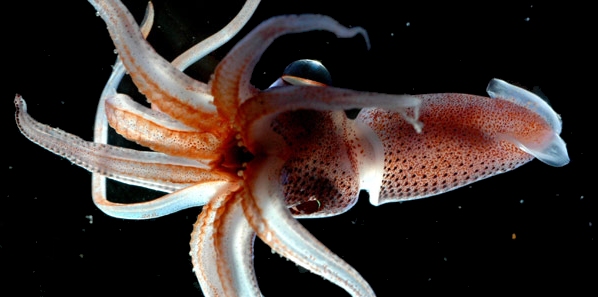
| #4 - Vampyroteuthis Infernalis |
This seldom-seen haunter in the dark is the only living species in its order, the Vampyromorphidae,
believed to have been far more common and far larger during the mid-Jurassic period. Its latin
name literally translates as "vampire squid from hell," a fact that no narrator can possibly resist
sharing. Outwardly similar to the dumbo octopuses, it differs from the rest of the octopods by a pair
of thin, retractable sensory filaments that can extend far beyond the length of its body. Its skin
appears red or black depending on lighting conditions, and its eyes - proportionally the largest in
the animal kingdom - appear red or blue.
believed to have been far more common and far larger during the mid-Jurassic period. Its latin
name literally translates as "vampire squid from hell," a fact that no narrator can possibly resist
sharing. Outwardly similar to the dumbo octopuses, it differs from the rest of the octopods by a pair
of thin, retractable sensory filaments that can extend far beyond the length of its body. Its skin
appears red or black depending on lighting conditions, and its eyes - proportionally the largest in
the animal kingdom - appear red or blue.
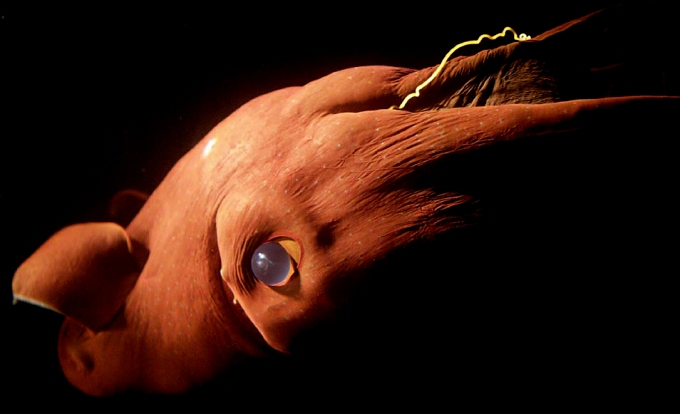


The body of Vampyroteuthis is almost completely covered in tiny, bright blue photophores, with
larger, brighter lights at the tentacle tips and an especially large, eye-like pair at the top of its head,
an array used in various ways to confuse predators. By slowly closing its false eyes, it can give the
impression of retreating while remaining in place. By flailing its tentacle-lights, it can imitate an
entire school of tiny creatures fleeing in different directions. Its light may also make it appear larger
to its attackers, give off a startling, blinding blast or pull the same stealth tricks as the jewel squid.
When all else fails, it wraps its fleshy web around its body and contracts into a tight, black ball.
larger, brighter lights at the tentacle tips and an especially large, eye-like pair at the top of its head,
an array used in various ways to confuse predators. By slowly closing its false eyes, it can give the
impression of retreating while remaining in place. By flailing its tentacle-lights, it can imitate an
entire school of tiny creatures fleeing in different directions. Its light may also make it appear larger
to its attackers, give off a startling, blinding blast or pull the same stealth tricks as the jewel squid.
When all else fails, it wraps its fleshy web around its body and contracts into a tight, black ball.
| #3 - Argonauta |
Closely related to Tremoctopus, female "Argonauts" are only ten to twenty times larger than the
males but far stranger in appearance. Unlike any other genus of octopus, females are able to
construct a shell-like egg case remarkably similar to the true shells of their ancestral ammonites.
Secreted by a pair of highly modified tentacles, this calcerous, papery structure gives the
animal its common name, "paper nautilus." A bubble of gas gives this false shell buoyancy, and the
mother faces outward to ward away predators with her venomous bite. Bizarrely, some species
have been seen attaching themselves to the tops of live jellyfish, feeding parasitically off their
gastric contents and adding an extra layer of defense to their mobile nursery.
males but far stranger in appearance. Unlike any other genus of octopus, females are able to
construct a shell-like egg case remarkably similar to the true shells of their ancestral ammonites.
Secreted by a pair of highly modified tentacles, this calcerous, papery structure gives the
animal its common name, "paper nautilus." A bubble of gas gives this false shell buoyancy, and the
mother faces outward to ward away predators with her venomous bite. Bizarrely, some species
have been seen attaching themselves to the tops of live jellyfish, feeding parasitically off their
gastric contents and adding an extra layer of defense to their mobile nursery.
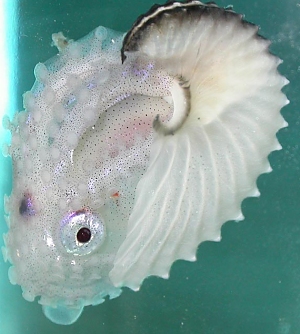


How and why an octopus - a completely shell-less mollusk - builds something so similar in
structure to the shells of its distant relatives is a subject of wide debate. It may very well be a case
of coincidence, but some theorize that their ancestors used discarded ammonite shells in much
the same way as a hermit crab. The "paper" shell may have originally been a lining for these
borrowed homes, but continued to be useful even after most of the shelled cephalopods went
extinct.
structure to the shells of its distant relatives is a subject of wide debate. It may very well be a case
of coincidence, but some theorize that their ancestors used discarded ammonite shells in much
the same way as a hermit crab. The "paper" shell may have originally been a lining for these
borrowed homes, but continued to be useful even after most of the shelled cephalopods went
extinct.
| #2 - Cuttlefish |
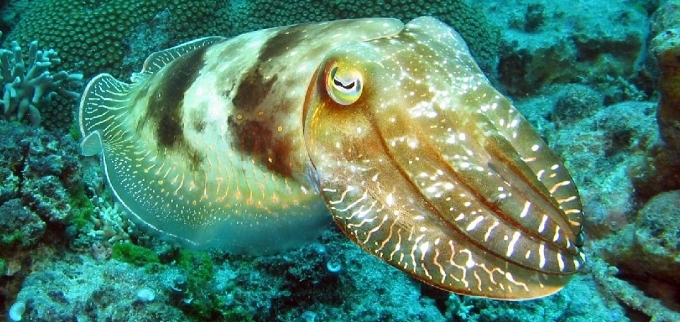
Perhaps best described as a sort of middle ground between octopus and squid, the cuttlefish are
technically related to the latter with the other Decapodiforms, but share the extreme camouflaging
skills of the Octopods and rival them in brainpower. More social than the octopuses, Cuttlefish
communicate with one another through a complex code of color shifts and tentacle signals. These
highly curious creatures have even been said to respond in kind to human hand gestures, though
their alien language may be forever lost on us. So skilled are these creatures with
chromatophores that they can animate the patterns on their bodies, and use psychedelic pulses
or flowing stripes to effectively mesmerize simple-minded prey.
technically related to the latter with the other Decapodiforms, but share the extreme camouflaging
skills of the Octopods and rival them in brainpower. More social than the octopuses, Cuttlefish
communicate with one another through a complex code of color shifts and tentacle signals. These
highly curious creatures have even been said to respond in kind to human hand gestures, though
their alien language may be forever lost on us. So skilled are these creatures with
chromatophores that they can animate the patterns on their bodies, and use psychedelic pulses
or flowing stripes to effectively mesmerize simple-minded prey.
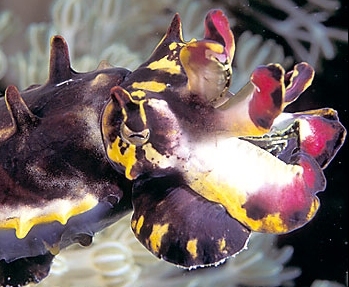

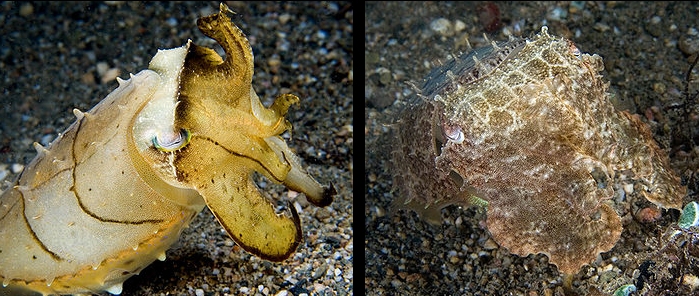
| #1 - The Mimic Octopus |
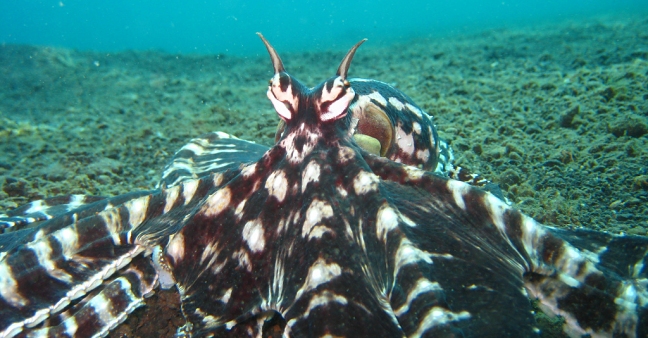
There are many animals that closely resemble other, more dangerous creatures as a defensive
mechanism, but the indonesian Thaumoctopus mimicus is the first animal ever discovered to
imitate both the esthetics and behavior of completely different species for different situations.
mechanism, but the indonesian Thaumoctopus mimicus is the first animal ever discovered to
imitate both the esthetics and behavior of completely different species for different situations.
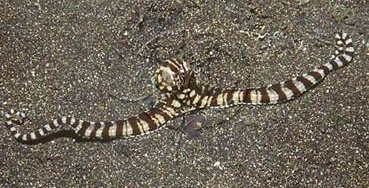
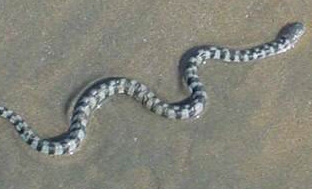
Here, a mimic octopus creates a false sea snake by taking on its
coloration and hiding all but two tentacles. This is often employed as a
defense against damselfish, which sea snakes have been known to hunt.
coloration and hiding all but two tentacles. This is often employed as a
defense against damselfish, which sea snakes have been known to hunt.
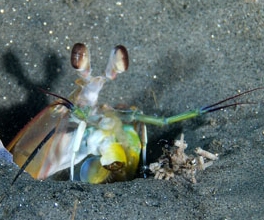
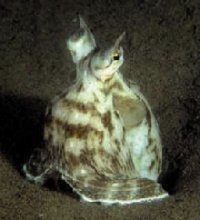
Another handy disguise is that of a Stomatopod or "Mantis Shrimp" - these crustaceans
are well known to man and animal alike for the incredible power of their bladed claws,
capable of shattering glass or snipping through bone.
are well known to man and animal alike for the incredible power of their bladed claws,
capable of shattering glass or snipping through bone.

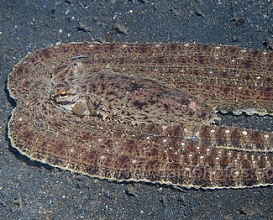
By flattening itself and skimming swiftly along he seafloor, the octopus
takes on the appearance of a flounder, a fish that the mollusk's
common predators might find distasteful.
takes on the appearance of a flounder, a fish that the mollusk's
common predators might find distasteful.
This is just a small peek at the mimic's bag of tricks. Over a dozen imitations have been
observed in a single specimen, and many more may yet be discovered. By rapidly changing
both its form and direction, it easily fools predators into thinking they've lost track of their
prey, and its preferred murky waters make the difference even tougher to spot - tough
enough that the species eluded human notice until the their formal discovery in only 1998.
Sadly, this incredible species may already be facing extinction through poaching - due
entirely to the prices they can fetch in the exotic pet trade. They are short lived in captivity,
many more die in transit and captive breeding is thus far unheard of. Hopefully, populations
of these dopplegangers may persist in still-unexplored regions of the tropical sea, and many
more species may still await discovery.
Perhaps someone you know has been an octopus all along...
Perhaps everyone but you.
observed in a single specimen, and many more may yet be discovered. By rapidly changing
both its form and direction, it easily fools predators into thinking they've lost track of their
prey, and its preferred murky waters make the difference even tougher to spot - tough
enough that the species eluded human notice until the their formal discovery in only 1998.
Sadly, this incredible species may already be facing extinction through poaching - due
entirely to the prices they can fetch in the exotic pet trade. They are short lived in captivity,
many more die in transit and captive breeding is thus far unheard of. Hopefully, populations
of these dopplegangers may persist in still-unexplored regions of the tropical sea, and many
more species may still await discovery.
Perhaps someone you know has been an octopus all along...
Perhaps everyone but you.
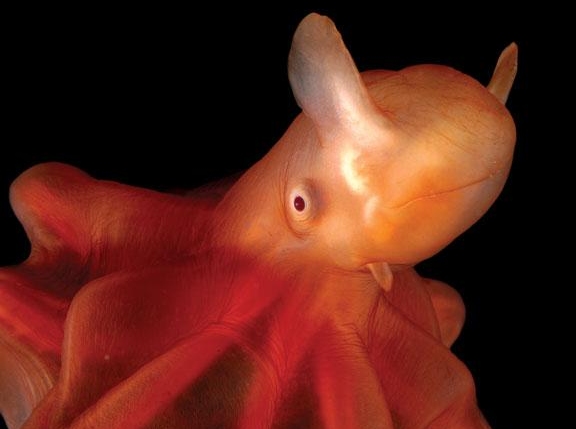
Cuttlefish are thought to have among the most well-developed eyes in the animal kingdom, and
begin to make use of them before they even hatch. Developing larvae actively observe the world
outside their transparent eggshells, and may demonstrate a life-long preference for whatever
prey species were most prevalent during this early stage of life.
begin to make use of them before they even hatch. Developing larvae actively observe the world
outside their transparent eggshells, and may demonstrate a life-long preference for whatever
prey species were most prevalent during this early stage of life.
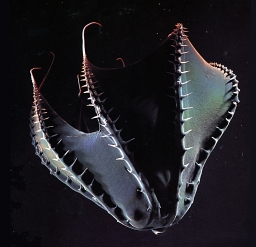
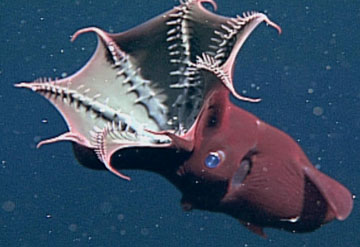
| Written by Jonathan C. Wojcik - Photo credits unknown or from public news outlets. |
| What could top my picks for the fifteen most amazing mollusks? Find out! |
| Photo by Laurence Madin, Woods Hole Oceanographic Institution |
| Image copyright MBARI |
| Images from TOLWEB |
| Dumbo Octopus by David Shale |
| Photo by Daniel Kwok |